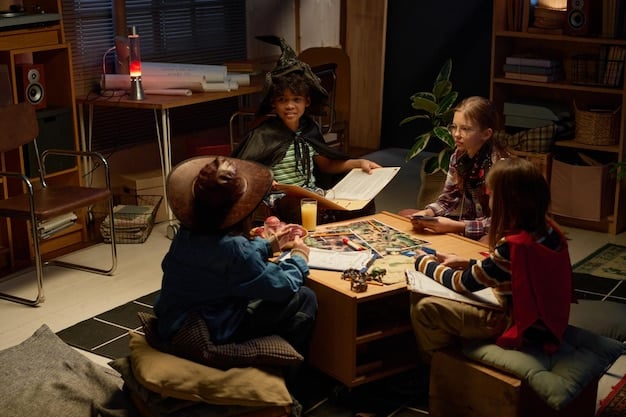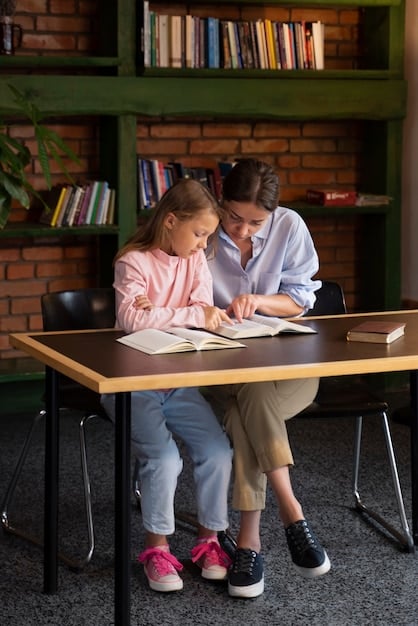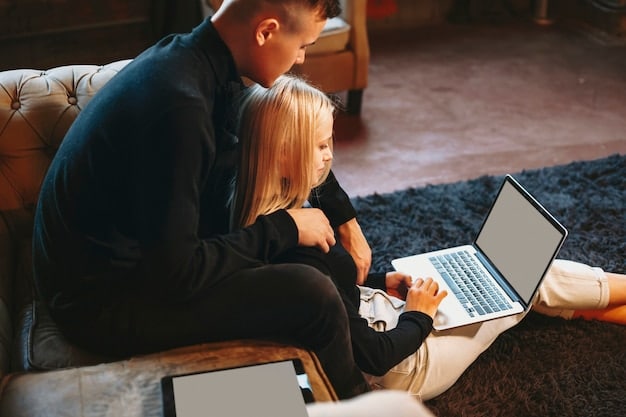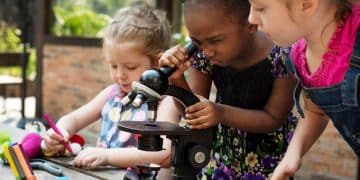Building a Strong Parent-Teacher Partnership: Tips for Effective Communication

Building a strong parent-teacher partnership is crucial for a child’s academic and emotional growth, fostering a supportive learning environment through effective communication, mutual respect, and shared goals.
A child’s success in school isn’t solely dependent on what happens within the four walls of the classroom. Building a strong parent-teacher partnership: tips for effective communication is crucial, because when parents and teachers work together, students thrive. This article explores actionable strategies to cultivate a collaborative and supportive relationship between home and school.
Why a Strong Parent-Teacher Partnership Matters
The connection between home and school is vital for a child’s overall development. When parents and teachers are on the same page, it creates a unified front that supports the child’s academic, social, and emotional well-being. A strong partnership ensures that the child receives consistent guidance and encouragement from both environments.
But what makes this partnership so crucial?
Enhanced Academic Performance
Studies show that students whose parents are actively involved in their education tend to perform better academically. When parents communicate regularly with teachers, they gain insights into their child’s strengths and weaknesses, allowing them to provide targeted support at home. This collaboration can lead to improved grades, increased engagement in learning, and a greater likelihood of academic success.
Improved Behavior and Attendance
A strong parent-teacher partnership can also positively impact a child’s behavior and attendance. When parents and teachers work together to address behavioral issues or attendance problems, they can develop consistent strategies that reinforce positive behavior and encourage regular attendance. This collaborative approach helps the child understand the importance of following rules and attending school, leading to a more disciplined and responsible attitude.

Here are some key benefits of a robust parent-teacher relationship:
- Increased student motivation and engagement
- Better understanding of the child’s learning style and needs
- Early identification and intervention for academic or behavioral challenges
- A supportive and collaborative learning environment
Ultimately, a strong parent-teacher partnership creates a positive ripple effect, benefiting the child, the family, and the school community as a whole. It sets the stage for a lifetime of learning and success.
Establishing Open Communication Channels
Effective communication is the cornerstone of any successful parent-teacher partnership. Establishing clear and consistent communication channels ensures that both parties are informed and can readily exchange information about the child’s progress, challenges, and needs. Without these channels, misunderstandings can arise, hindering the child’s educational journey.
How can you set up these lines of communication?
Utilizing School Communication Tools
Many schools offer a variety of communication tools, such as email, online portals, and mobile apps, to facilitate communication between parents and teachers. Parents should familiarize themselves with these tools and use them regularly to stay informed about school events, assignments, and important announcements. Teachers can also use these tools to provide parents with timely updates on their child’s progress and any concerns that may arise.
Scheduling Regular Meetings
In addition to using online communication tools, scheduling regular meetings between parents and teachers is essential. These meetings provide an opportunity for in-depth discussions about the child’s academic performance, behavior, and overall well-being. Parents can use these meetings to ask questions, share concerns, and collaborate with the teacher on strategies to support the child’s learning. Teachers can use these meetings to provide parents with detailed feedback and insights into the child’s progress.
Here are several communication methods that could be tested:
- Regularly check and respond to emails from teachers.
- Attend parent-teacher conferences and ask questions.
- Utilize school communication apps or portals to stay informed.
- Schedule brief phone calls or virtual meetings to discuss specific concerns.
Establishing open channels for communication is a continuous process that requires effort and commitment from both parents and teachers. By prioritizing communication, you create a solid foundation for a strong and effective partnership.
Active Listening and Empathy
Beyond simply exchanging information, active listening and empathy are crucial components of a successful parent-teacher partnership. When parents and teachers genuinely listen to each other and try to understand each other’s perspectives, they can build trust and create a more collaborative relationship. Practicing these skills can transform interactions and foster mutual respect.
Let’s explore what this really means.
Understanding Different Perspectives
Parents and teachers often have different perspectives on the child’s education. Parents see the child in the home environment, where they may be more relaxed and comfortable. Teachers see the child in the school environment, where they may be more focused and disciplined. Understanding these different perspectives is essential for developing a comprehensive understanding of the child’s strengths, weaknesses, and needs.
Practicing Empathetic Communication
Empathetic communication involves listening attentively to the other person’s point of view, acknowledging their feelings, and responding in a way that shows you understand their perspective. When parents and teachers practice empathetic communication, they create a safe and supportive environment where they can openly share their thoughts and concerns without fear of judgment. This can lead to more productive and collaborative discussions.

To improve listening with empathy, consider incorporating these tips:
- Actively listen to understand, not just to respond.
- Acknowledge and validate the other person’s feelings.
- Ask clarifying questions to ensure you understand their perspective.
- Avoid interrupting or dominating the conversation.
Active listening and empathy build a bridge between parents and teachers, fostering a deeper connection and a shared commitment to the child’s success. This approach ensures that everyone feels heard and valued.
Setting Shared Goals and Expectations
For a parent-teacher partnership to truly thrive, it’s essential to establish shared goals and expectations for the child’s learning and development. When parents and teachers are working towards the same objectives, it creates a sense of unity and purpose, enabling them to provide consistent support and guidance. A lack of alignment can lead to confusion and a disjointed approach to the child’s education.
How do you go about setting these goals?
Collaboratively Defining Objectives
Parents and teachers should work together to define specific, measurable, achievable, relevant, and time-bound (SMART) objectives for the child’s academic performance, behavior, and social-emotional development. These objectives should be tailored to the child’s individual needs and abilities, and they should be regularly reviewed and adjusted as needed. Collaboratively defining objectives ensures that both parties are invested in the child’s success and are working towards the same outcomes.
Creating a Consistent Approach
Once shared goals have been established, parents and teachers should work together to create a consistent approach to supporting the child’s learning and development. This may involve implementing similar strategies at home and at school, such as using positive reinforcement techniques, providing additional support for struggling subjects, or encouraging participation in extracurricular activities. A consistent approach reinforces positive behavior, enhances learning, and promotes a sense of stability and security for the child.
A few areas to focus on when setting goals are:
- Academic goals: Improving grades in a specific subject; developing better study habits
- Behavioral goals: Reducing disruptive behavior in class; improving social skills
- Social-emotional goals: Building confidence; developing empathy
By setting shared goals and creating a consistent approach, parents and teachers can create a powerful synergy that propels the child towards success. This alignment fosters a sense of security and understanding for the child.
Addressing Conflicts and Concerns Constructively
In any partnership, conflicts and concerns are bound to arise. The key is to address these issues constructively, with a focus on resolving them in a way that benefits the child. Ignoring or avoiding conflicts can lead to resentment and undermine the partnership, ultimately impacting the child’s well-being. Healthy resolution strategies are crucial.
Let’s discuss how to address disagreements:
Open and Respectful Dialogue
When conflicts arise, parents and teachers should engage in open and respectful dialogue to understand each other’s perspectives. This involves actively listening to each other’s concerns, acknowledging their feelings, and expressing your own thoughts and feelings in a calm and respectful manner. Avoid making accusations or blaming the other person, and focus on finding a solution that works for everyone involved.
Seeking Mediation When Necessary
In some cases, conflicts may be difficult to resolve on your own. In these situations, seeking mediation from a neutral third party, such as a school counselor or administrator, can be helpful. A mediator can facilitate communication, help you identify common ground, and guide you towards a mutually acceptable resolution. Mediation can be a valuable tool for resolving complex or emotionally charged conflicts.
To navigate conflicts effectively, incorporate these steps:
- Address concerns promptly and directly.
- Focus on the issue, not the person.
- Seek clarification to ensure understanding.
- Be willing to compromise and find common ground.
By addressing conflicts and concerns constructively, parents and teachers can strengthen their partnership and create a more positive and supportive environment for the child. This proactive approach fosters trust and resolution.
Celebrating Successes and Milestones
A strong parent-teacher partnership isn’t just about addressing challenges; it’s also about celebrating successes and milestones. Recognizing and acknowledging the child’s accomplishments, no matter how small, can boost their confidence, motivation, and sense of self-worth. Celebrating these moments reinforces the positive impact of the partnership.
Let’s consider how to highlight achievements:
Acknowledging Achievements
Parents and teachers should make a conscious effort to acknowledge the child’s achievements, both academic and non-academic. This could involve praising the child’s effort, showcasing their work, or awarding certificates or small prizes. Acknowledging achievements shows the child that their hard work is valued and appreciated, encouraging them to continue striving for excellence.
Sharing Positive Feedback
Sharing positive feedback between parents and teachers is also essential. Parents can share positive feedback about the child’s behavior or academic progress at home, while teachers can share positive feedback about the child’s performance in the classroom. Sharing positive feedback reinforces the child’s strengths and provides them with a sense of pride and accomplishment. It also strengthens the partnership by fostering a culture of encouragement and appreciation.
Ways to celebrate success include:
- Verbal praise and encouragement.
- Written notes of appreciation.
- Small rewards or treats.
- Celebrating achievements with family and friends.
Celebrating successes and milestones is a powerful way to strengthen the parent-teacher partnership and create a positive and supportive learning environment for the child. This positive reinforcement fosters motivation and a sense of accomplishment.
| Key Point | Brief Description |
|---|---|
| 🤝 Open Communication | Establish clear channels for exchanging information regularly. |
| 👂 Active Listening | Practice understanding each other’s perspectives with empathy. |
| 🎯 Shared Goals | Collaboratively set objectives to provide consistent support. |
| 🎉 Celebrate Successes | Recognize and celebrate the child’s achievements to boost motivation. |
Frequently Asked Questions (FAQs)
Start by sending a brief email or note expressing your interest in partnering with them. Request a convenient time for a short phone call or meeting to discuss your child’s needs and goals.
Schedule a private meeting to discuss your concerns respectfully and openly. Listen to their perspective, share yours calmly, and work together to find a compromise that benefits your child.
Regular check-ins are beneficial, especially if there are specific concerns. Aim for at least monthly communication, even if it’s just a quick email or a note to stay updated on your child’s progress.
Reach out to the teacher immediately to discuss specific challenges. Collaborate on a plan that includes additional support, tutoring, or modified assignments to help your child catch up and succeed.
Offer to volunteer in the classroom, provide necessary supplies, or assist with special projects. Showing your support can ease the teacher’s workload and create a more positive learning environment.
Conclusion
In conclusion, building a strong parent-teacher partnership: tips for effective communication is not just beneficial, but essential for a child’s comprehensive development. By prioritizing open communication, active listening, shared goals, constructive conflict resolution, and the celebration of achievements, parents and teachers can create a powerful alliance that enriches the child’s educational journey and sets them up for lifelong success.





